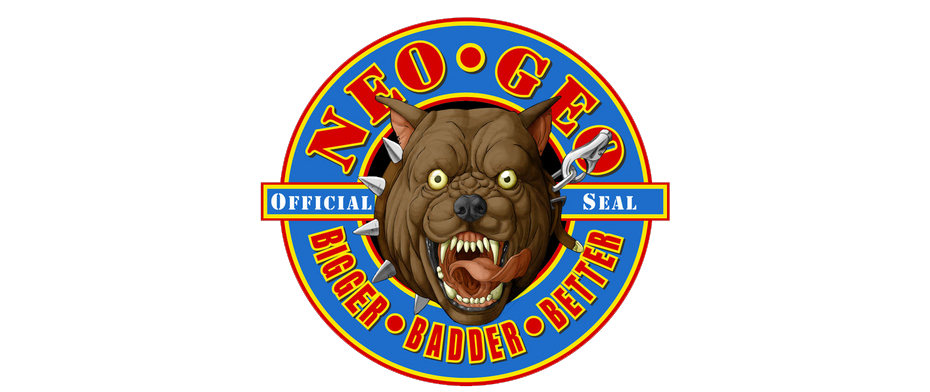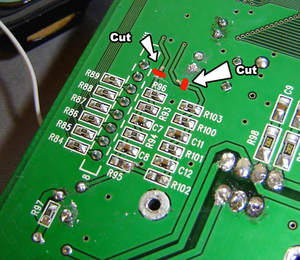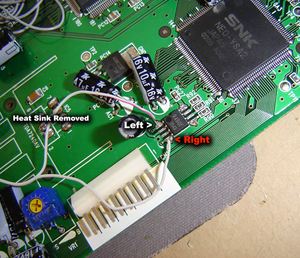Difference between revisions of "How to Consolize an MVS Board"
XianXi-12537 (talk | contribs) m |
XianXi-12537 (talk | contribs) |
||
| Line 93: | Line 93: | ||
==Adding Controller Ports== | ==Adding Controller Ports== | ||
| + | [[Image:Db15.png]] | ||
| + | Above is a picture of a DB15 controller port. Now for these projects you do not "have to" use these ports since you are making it your own. But if you would like to use your existing Neo Geo controllers you should use them unless you will also build a small converter that has a DB15 connector to convert to your custom pinout if you choose. | ||
| + | |||
| + | The standard Neo Geo Controller pinout is: | ||
==Adding a Bios Socket== | ==Adding a Bios Socket== | ||
Revision as of 00:58, 15 September 2008

In This Guide
In this guide I will show you how to consolize an MV-1C MVS board. What is consolization you ask?
Consolization is basically turning an arcade board which is made to be played in an arcade cab playable on a regular TV with control pads just like any other home console, hence the name "Consolization". The difference between a CMVS and a supergun is that a CMVS is a "dedicated" supergun that only plays MVS games.
This is where you ask yourself do you want to make a CMVS or a supergun. You decide.
Parts Needed
- Wiring (I use 22 awg usually)
- Solder (I prefer leaded 2% silver)
- Soldering Gun
- Audio, Video and Power Jacks (I use color coded Gold Panel Mounts)
- RGB > NTSC Video Encoder (Neobitz, JROK or similar)
- +5v Power Supply, I prefer this one from Jameco.
- Dremel or Xacto Knife for cutting
- DB15 Controller Ports
- Ice Cold Beer (After Completion)
Enclosures
For enclosures it is all up to you, you can either do an "Open Face" CMVS which is a bare board with no fancy enclosure or a fully cased CMVS. Keep in mind that putting an MVS board into a case can be difficult and also may take you a while to find an enclosure you like.
Several companies make plastic, wood and metal enclosures. Hammond Manufacturing makes both plastic and metal ones. Other companies like PacTec only make plastic ones. Some CMVS builder have used Plexiglass, old PC cases and even NGH and NeoCD cases. Making an "Open Face" CMVS takes about 3-5 days to complete depending on cleanliness. An enclosed CMVS can take up to 3 weeks depending on difficulty with the casing material. However an "Open Face" 2 slot will only take you about 8 hours or less total build time, this is due to having everything you need already on the board and all you need is a PSU and RGB > NTSC Encoder.
Stereo Sound Mod
The MV-1C board does not give Stereo Sound off the jamma edge so you will need to do a simple hack to achieve Stereo Sound.
First, you need to remove the heat sink on the board. That is the big silver thing on the bottom right corner of the board. You can remove it by either desoldering it or just clipping the legs. I don't ever plan on re-using them so I just cut the legs and then desolder the 2 posts holding it to the board.
Click on the images for a larger view
In figure 1-1 you will need to cut the 2 traces indicated. You can use an Xacto knife to cut them but I prefer to use a dremel to kind of carve it out a little to ensure that the traces are no more.
In figure 1-2 is the onboard sound chip on the MV-1C. Gently bend back the surrounding capacitors to get to Pins 1 & 4. Solder a wire to each pin. Pin 1 is audio Left Pin 4 is audio Right
Powering the Board
Powering the board is simple, you just provide +5v and ground. With the PSU I recommended all you need is a panel mount 2.1mm barrel jack which can also be purchased a Jameco. The barrel jack has 3 pins but you will only be using 2 of them. Remember that the PSU has positive tip polarity which means that the center pin will carry the +5v supply, the edge will be the ground. I always use a multimeter as a habit when doing it just to ensure everything is correct. Just mount the barrel jack and plug in the psu without wiring it to the board and use your tester to check which pin is which.
The Video Encoder
For the Video Encoder I always use the Neobitz as it's the best for the Neo. The JROK is exceptional as well. This is just personal preference. Here you can choose which video outputs you would like.
- Composite - Most commonly known as the "Yellow" on those Red, White and Yellow A/V Cords. Composite uses 1 wire to transfer video data.
- S-Video - AKA S-VHS, provides better video quality than the composite. S-Video uses 2 wires to transfer video data.
- Component - AKA Color Difference AKA RGB by n00bs. Just to clear things up, Component is not RGB it is a different system.
- Straight RGB - If you have a TV that can take straight RGB then you dont need an encoder but you will need to wire up a custom adapter to transfer the signal to your TV.
Depending on what outputs you want the price of course changes. Composite and S-video go hand-in-hand as both signals come off the same chip. There is usually about a $30-50 difference between an encoder that outputs Composite with S-video and an encoder that outputs all three.
Usually the JROKs and Neobitz boards come with the Panel Mount jacks that you need, they come with the basic ones but for a little more money you can upgrade to gold jacks which offer better connectivity as well as endurance against the elements.
Adding Controller Ports
Above is a picture of a DB15 controller port. Now for these projects you do not "have to" use these ports since you are making it your own. But if you would like to use your existing Neo Geo controllers you should use them unless you will also build a small converter that has a DB15 connector to convert to your custom pinout if you choose.
The standard Neo Geo Controller pinout is:


